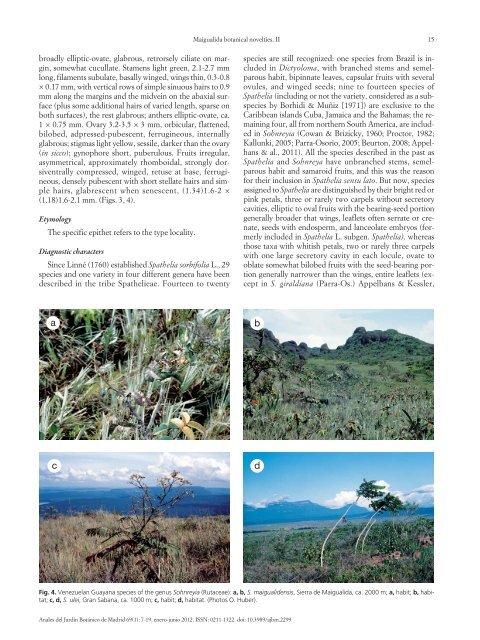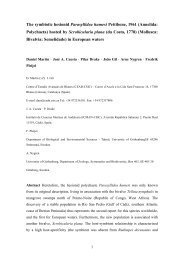Botanical novelties from Sierra de Maigualida, southern ... - CSIC
Botanical novelties from Sierra de Maigualida, southern ... - CSIC
Botanical novelties from Sierra de Maigualida, southern ... - CSIC
Create successful ePaper yourself
Turn your PDF publications into a flip-book with our unique Google optimized e-Paper software.
<strong>Maigualida</strong> botanical <strong>novelties</strong>. II<br />
15<br />
broadly elliptic-ovate, glabrous, retrorsely ciliate on margin,<br />
somewhat cucullate. Stamens light green, 2.1-2.7 mm<br />
long, filaments subulate, basally winged, wings thin, 0.3-0.8<br />
× 0.17 mm, with vertical rows of simple sinuous hairs to 0.9<br />
mm along the margins and the midvein on the abaxial surface<br />
(plus some additional hairs of varied length, sparse on<br />
both surfaces), the rest glabrous; anthers elliptic-ovate, ca.<br />
1 × 0.75 mm. Ovary 3.2-3.5 × 3 mm, orbicular, flattened,<br />
bilobed, adpressed-pubescent, ferrugineous, internally<br />
glabrous; stigmas light yellow, sessile, darker than the ovary<br />
(in sicco); gynophore short, puberulous. Fruits irregular,<br />
asymmetrical, approximately rhomboidal, strongly dorsiventrally<br />
compressed, winged, retuse at base, ferrugineous,<br />
<strong>de</strong>nsely pubescent with short stellate hairs and simple<br />
hairs, glabrescent when senescent, (1.34)1.6-2 ×<br />
(1.18)1.6-2.1 mm. (Figs. 3, 4).<br />
Etymology<br />
The specific epithet refers to the type locality.<br />
Diagnostic characters<br />
Since Linné (1760) established Spathelia sorbifolia L., 29<br />
species and one variety in four different genera have been<br />
<strong>de</strong>scribed in the tribe Spathelieae. Fourteen to twenty<br />
species are still recognized: one species <strong>from</strong> Brazil is inclu<strong>de</strong>d<br />
in Dictyoloma, with branched stems and semelparous<br />
habit, bipinnate leaves, capsular fruits with several<br />
ovules, and winged seeds; nine to fourteen species of<br />
Spathelia (including or not the variety, consi<strong>de</strong>red as a subspecies<br />
by Borhidi & Muñiz [1971]) are exclusive to the<br />
Caribbean islands Cuba, Jamaica and the Bahamas; the remaining<br />
four, all <strong>from</strong> northern South America, are inclu<strong>de</strong>d<br />
in Sohnreyia (Cowan & Brizicky, 1960; Proctor, 1982;<br />
Kallunki, 2005; Parra-Osorio, 2005; Beurton, 2008; Appelhans<br />
& al., 2011). All the species <strong>de</strong>scribed in the past as<br />
Spathelia and Sohnreya have unbranched stems, semelparous<br />
habit and samaroid fruits, and this was the reason<br />
for their inclusion in Spathelia sensu lato. But now, species<br />
assigned to Spathelia are distinguished by their bright red or<br />
pink petals, three or rarely two carpels without secretory<br />
cavities, elliptic to oval fruits with the bearing-seed portion<br />
generally broa<strong>de</strong>r that wings, leaflets often serrate or crenate,<br />
seeds with endosperm, and lanceolate embryos (formerly<br />
inclu<strong>de</strong>d in Spathelia L. subgen. Spathelia), whereas<br />
those taxa with whitish petals, two or rarely three carpels<br />
with one large secretory cavity in each locule, ovate to<br />
oblate somewhat bilobed fruits with the seed-bearing portion<br />
generally narrower than the wings, entire leaflets (except<br />
in S. giraldiana (Parra-Os.) Appelhans & Kessler,<br />
a<br />
b<br />
c<br />
d<br />
Fig. 4. Venezuelan Guayana species of the genus Sohnreyia (Rutaceae): a, b, S. maiguali<strong>de</strong>nsis, <strong>Sierra</strong> <strong>de</strong> <strong>Maigualida</strong>, ca. 2000 m; a, habit; b, habitat;<br />
c, d, S. ulei, Gran Sabana, ca. 1000 m; c, habit; d, habitat. (Photos O. Huber).<br />
Anales <strong>de</strong>l Jardín Botánico <strong>de</strong> Madrid 69(1): 7-19, enero-junio 2012. ISSN: 0211-1322. doi: 10.3989/ajbm.2299
















